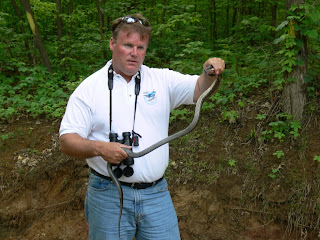I braved the 90+ heat and humidity, and bushwhacked for about three miles through some of my favorite hidden spots today. A primary objective was spending some quality time with my Nikon D7000, which I am still very much learning. So, as I slogged through fens and woodlands, I was especially on the lookout for tiny stuff, as I really wanted to use the 105mm macro. I found lots of suitable subjects, and more on some of those later. But, the following beast was a huge bonus and a macro lens was scarcely necessary!
A dead twig where it didn't look like a dead twig should be. A closer glance revealed movement. My lucky day - a hickory horned devil! This enormous caterpillar is sort of the Holy Grail for caterpillar-seekers, with good reason. They are spectacular.
I backed the car off a few feet, jumped out and started hauling out the camera gear. Even after setting my tripod a few feet away, the devil paid no mind - it just continued slowly browsing the hickory foliage. This monstrosity was probably four inches in length, and is due to get even bigger. I'd say it's in its next to final instar. Horned devils become green in their last larval stage. I was sorely tempted to take it back home with some hickory foliage, and see if I could raise the animal to adulthood. But these sorts of things are better left alone unless you've got some really justifiable reason for collecting.
At one point, I reached in to adjust a leaf, and that movement caught the caterpillar's attention. It lunged that ferocious looking horned head in my direction with great rapidity, and splayed its horns for full effect. Hickory horned devils are harmless, of course, but if you didn't know what it was, this menacing display would probably cause you to back off. If the caterpillar is threatened by a potential predator such as a songbird or perhaps parasitoid flies or wasps, this act might be enough to save it. Interestingly, a Yellow-billed Cuckoo was calling intermittently close at hand as I made these photos. Cuckoos are MAJOR caterpillar hunters, and that bird probably would have loved this thing.
The tubular glutton still has a piece of hickory leaf in its jaws. Note also the curious handlike "feet" capping the prolegs. Caterpillars are eating machines, and a big hickory horned devil can tear through some serious foliage. As greenery is mowed down and sucked into the front end, the inedible remnants are constantly expelled out the back end. Hickory horned devil frass - poop - pellets can be a centimeter in length. The first one of these that I ever saw was because of its frass. The person I was with with spotted a pile of fresh frass, looked up into the tree, and there was the devil chomping away.
The caterpillar was copiously beset with small branched spines. I think that most or all of these are shed when it molts into the final instar.
Those are some big, powerful legs and the horned devil uses them to tightly clasp twigs. It'd probably have been some work to pry it off there, but such grasping power comes in handy during storms and the attendant threat of being blown from the tree.
If all goes well and this hickory horned devil makes it to adulthood, this is what it will become. A royal walnut moth, Citheronia regalis. That's a suitably apropos scientific epithet, as both the caterpillar and the moth are certainly regal.

















































